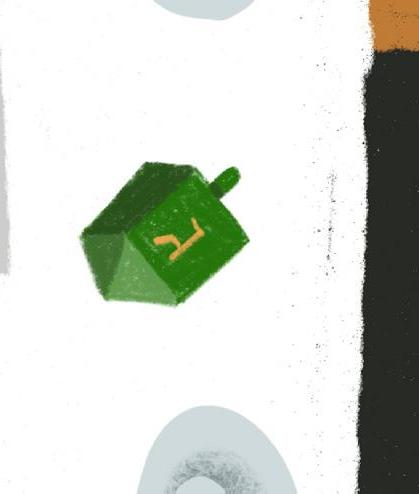
4 minute read
Chanukah Customs
In addition to lighting the menorah at home, Jewish communities have adopted a rich variety of customs in honor of the holiday, each with its own unique symbolism and meaning.
FOOD MADE WITH OIL The custom to consume foods with oil, commemorating the miracle of the menorah oil, goes back many centuries. An eighteenth-century rabbi in Morocco testifies that he saw a manuscript written by Rabbi Maimon (born ca. 1110 CE), father of Maimonides, noting the importance of consuming “sufganim,” meaning fried desserts, on Chanukah. From here we have the widely-observed custom of eating donuts on the holiday today. Another beloved holiday tradition, rooted in the Jewish communities of Central and Eastern Europe and further popularized with their mass immigration to the United States, is to eat fried potato latkes. One of the earliest American Jewish cookbooks, Aunt Babette’s Cookbook: Foreign and Domestic Recipes for the Household, published in Cincinnati in 1889, includes a latke recipe. DAIRY FOODS Judith, a Jewish woman of great valor, managed to singlehandedly neutralize an army that threatened to hurt her people. After gaining access to an enemy commander’s quarters under the pretense of friendship, she served him cheese, which rendered him thirsty and eager to drink her wine. Once he was inebriated and had fallen asleep, she killed him. A number of sources place this story in the context of Chanukah. To commemorate this victory and Judith’s courage, we consume dairy foods on Chanukah.
Advertisement
ILLUSTRATION BY ANNITA SOBLE
DREIDEL A number of seventeenth-century sources indicate that European Jews would play games involving dice on Chanukah. In time, the dreidel, a squared spinning toy, became the norm, with the letters nun, gimel, hei, and shin written on its four sides. Rabbi Yitschak of Radvil (1751–1835) writes that in his day, it was widely understood that these letters were an acronym for םש היה לודג סנ, “a great miracle occurred there”—the Chanukah miracles that transpired in the Land of Israel. A famous book on Jewish customs, published in 1930, proposes that when the SyrianGreeks forbade the Jews from teaching Torah, their children would continue to study Torah in secret, at great risk, by pretending to simply be gathering to play dice.

CHANUKAH GELT A notable Chanukah custom is for parents (and other relatives) to give children gifts of money. One explanation for this custom points to the name Chanukah itself, which in the Hebrew language comes from the word chinuch, “education.” After being unable to teach their children Torah during the period of oppressive occupation, the Jews who lived through the Chanukah story had to begin the education process anew for their children. Giving gifts of money was a way to incentivize these renewed Torah studies. It also carries a great message that is of particular relevance to education: On its own, money satisfies none of our human needs; but with some effort, it can be used to purchase the things we require. In the same way, G-d has given each of us vast resources to learn and grow—but they only become useful if we tap into them and “cash in.” MEGILAH There was once a common custom to read a special megilah in the synagogue recounting the story of Chanukah. Called Megilat Antiochus or Megilat Beit Chashmona’i, the text of this megilah, written in Aramaic, is quite ancient, with some attributing its authorship to the students of Hillel and Shamai, who lived during the first century CE. This custom is still observed today by some Jews with roots in the Middle East. Others suffice with a brief text that is inserted into the Amidah and Grace after Meals.
PUBLIC LIGHTING The obligation to kindle the menorah pertains to the home. It is also customary, however, to light the menorah in the synagogue each evening of Chanukah. This practice began when repressive regimes made it difficult for Jews to light the candles outside of their homes. Unable to publicize the miracle from home, Jews began kindling the menorah at the synagogue (in addition to inside their homes) so that the entire community could witness and participate in the commemoration—a modicum of publicity. Today it is common for public lightings to take place in public areas.
SOURCES
Food Made with Oil For the quote from Rabbi Maimon, see Rabbi Yehudah Toledano, Kovets Sarid Vepalit, p. 8 (Jerusalem, 1945). About latkes, see Carol Green Ungar, “The Little Known Story Behind the Latke,” Jewish Action, Winter 2013.
Dairy Foods See Otsar Hamidrashim 1, pp. 192–193; Rashi, Shabbat 23a; Shulchan Aruch, Orach Chayim 670:2.
Dreidel Regarding the seventeenth century, see Responsa Chavot Ya’ir 126. The quote from Rabbi Yitschak can be found in Or Yitschak (Jerusalem 1966), p. 79. The book from 1930 is Otsar Kol Minhagei Yeshurun (Lvov, 1930) 19:4.
Chanukah Gelt The explanation provided is from Likutei Levi Yitschak: Tanach Umaamarei Chazal, p. 358, and Igrot Kodesh 28, pp. 76–77.
Megilah See Halachot Gedolot (Berlin, 1888), vol. 3, p. 615. See further Rabbi Yitschak Ratsabi, Shemen Lama'or, pp. 45ff.; Minhagei Yisrael 5, pp. 102–120.
Public Lighting Shulchan Aruch, Orach Chayim 671:7; Responsa Rivash 111.







